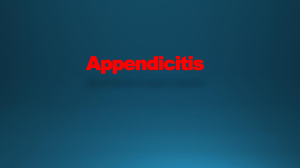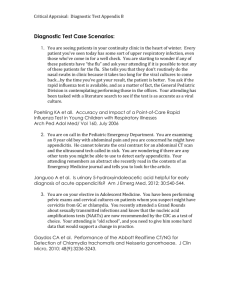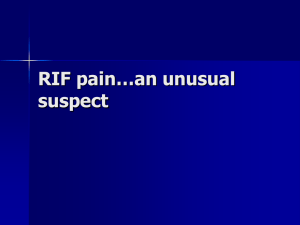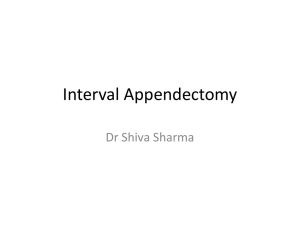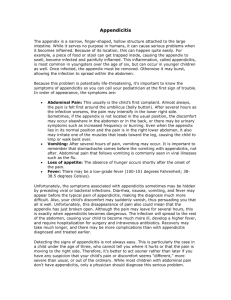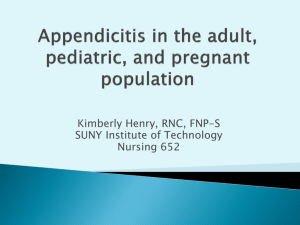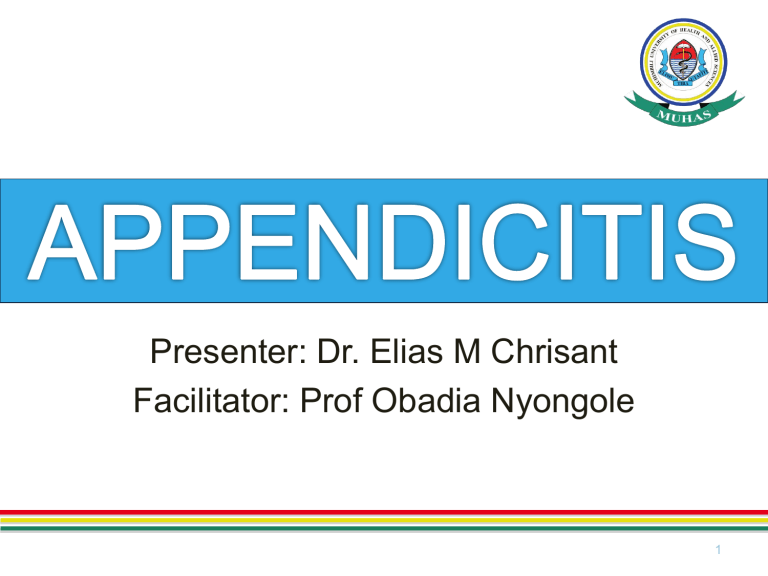
Presenter: Dr. Elias M Chrisant Facilitator: Prof Obadia Nyongole 1 Outline • • • • • • • • • • • Definition A historical perspective Epidemiology Etiology Classification Pathophysiology Clinical presentation Differential Diagnosis Work up Treatment Complications. 2 DEFINITION • Appendicitis refers to inflammation of the vermix appendix 3 A HISTORICAL PERSPECTIVE • First described by Reginald Fitz in 1886 who also was the first to advocate appendicectomy as the cure • In 1889 Charles McBurney described the clinical findings of acute appendicitis including the point of maximum tenderness in RIF which bears his name 4 EPIDEMIOLOGY • Incidence: – The incidence is higher in developed countries and in developing countries which are adopting a more refined western type diet – Incidence of appendicitis is lower in cultures with a higher intake of dietary fiber 5 EPIDEMIOLOGY [cont’d] • Mortality/Morbidity: – The overall mortality rate of 0.2-0.8% is attributable to complications of the disease rather than to surgical intervention – Mortality rate rises above 20% in patients older than 70 years, primarily because of diagnostic and therapeutic delay – Perforation rate is higher among patients younger than 18 years and patients older than 50 years, possibly because of delays in diagnosis – Appendiceal perforation is associated with an increase in morbidity and mortality rates 6 EPIDEMIOLOGY [cont’d] • Sex: – The incidence of appendicitis is approximately 1.4 times greater in men than in women – The incidence of primary appendicectomy is approximately equal in both sexes 7 EPIDEMIOLOGY [cont’d] • Age: – Appendicitis may occur at all ages, but is most commonly seen in the 2nd and 3rd decades of life – The incidence of appendicitis gradually rises from birth, peaks in the late teen years, and gradually declines in the geriatric years – Although rare, neonatal and even prenatal appendicitis have been reported in literature – The emergency physician must maintain a high index of suspicion in all age groups 8 AETIOLOGY • Etiological factors for appendicitis include:– Appendiceal luminal obstruction – Diet – Social status – Familial susceptibility 9 Appendiceal luminal obstruction • Luminal causes – – – – Feacolith Lymphoid follicle hyperplasia Worms e.g. ascaris Foreign body • In the wall – Stricture – Neoplasms • Outside the wall – Adhesions – kinks 10 Diet • Low intake of dietary fiber is associated with increased incidence of appendicitis • Dietary fiber is thought to decrease the viscosity of feces, decrease bowel transit time, and discourage formation of faecaliths that predispose individuals to obstructions of the Appendiceal lumen. 11 Familial tendency • Appendicitis tends to run in certain families may be due to peculiar position of the organ which predisposes to infection 12 CLASSIFICATION • Clinical classification • Pathological classification 13 Clinical classification • • • • Acute appendicitis Sub-acute appendicitis Recurrent appendicitis Chronic appendicitis 14 Pathological classification • Obstructive appendicitis • Non-obstructive appendicitis 15 PATHOPHYSIOLOGY • Two types:– Obstructive appendicitis – Non-obstructive appendicitis 16 Obstructive appendicitis • Luminal obstruction and mucus production result in increased intraluminal pressure • Bacteria trapped within the Appendiceal lumen begin to multiply, and the appendix becomes distended • Luminal distention stimulates visceral nerve endings concerned with pain [visceral pain] • This produce dull aching pain felt periumbilically according to nerve supply of the appendix (T10) referred pain • Venous congestion and edema follow next, and by 12 hours after onset, the inflammatory process may become transmural 17 Obstructive appendicitis [ cont.] • Peritoneal irritation then develops • If the obstruction is left untreated, arterial blood flow to the appendix is compromised, and this leads to tissue ischemia and necrosis • This stimulates parietal nerve endings shift of pain to the RIF • Full thickness necrosis of the Appendiceal wall leads to perforation with the release of fecal and suppurative contents into the peritoneal cavity 18 Obstructive appendicitis [cont.] Depending on the duration of the disease process, either a localized walled-off abscess or mass occurs, or if the pathologic process has advanced rapidly, the perforation is free in the peritoneal cavity and generalized peritonitis occurs The commonest bacterial growth from inflamed appendices include Escherichia coli, Kleblesiella spp., Proteus spp and Bacteroids 19 Non-obstructive appendicitis • This is less dangerous type • Inflammation commences in the mucous membrane or in the lymphoid follicles and gradually spread to the sub mucosa • As there is no obstruction there is not much distension, but when the serosa is involved localizing peritonitis develops and the patient c/o RIF pain • Such inflammation terminates either by:– – – – Suppuration Gangrene Fibrosis Resolution • Many of the sub-acute appendicitis, recurrent appendicitis and chronic appendicitis develop from this variety 20 CLINICAL PRESENTATION • History: classic symptoms include:– Periumbilical pain [visceral pain] which shifts and localize to the RIF [parietal or somatic pain] – Periumbilical pain is colicky in nature in obstructive type and is dull aching and constant in non-obstructive type – RIF pain is sharp intense and well localized to the RIF – Anorexia – Nausea & Vomiting 21 CLINICAL PRESENTATION [cont’d] • Physical examination – Pyrexia – RIF tenderness – Muscle guarding – Rebound tenderness – Special test to elicit in appendicitis • Pointing sign[The pt will point where the pain begun and where it moved] • Rovsing’s sign [RIF pain with palpation or purcasion of the LIFdue to referred pain ] • Obturator sign [RIF pain with passive internal rotation of the flexed right hip] • Psoas sign [RLQ pain with hyperextension of the right hip If the appendix is lying near the psoas muscle ] 22 DIFFERENTIAL DIAGNOSIS • • • • • Abdominal disorders Gynecological disorders Retroperitoneal disorders Thoracic disorders Others 23 Abdominal disorders • • • • • • • • • Acute cholecytitis Perforated peptic ulcers Enterocolitis Intestinal obstruction Carcinoma caecum Crohn’s diseases Amoebic colitis Meckel’s diverticulitis Acute pancreatitis 24 Gynecological disorders • • • • Pelvic Inflammatory Disease (PID) Ectopic pregnancy Twisted ovarian cyst Ruptured ovarian follicles 25 Retroperitoneal disorders • • • • Right ureteric colic Right sided acute pyelonephritis Right sided testicular torsion Retroperitoneal hematoma. 26 Thoracic disorders • Basal pneumonia • Pleurisy 27 Miscellaneous • Henoch-Schoenlein purpura • Porphyria • Diabetic abdomen 28 WORK UP • Lab investigations – Complete blood cell count • Leukocytosis • Neutrophilia greater than 75% – C-reactive protein test – Urinalysis 29 WORK UP [cont’d] • Imaging investigations – Abdominal radiography • The kidneys-ureters-bladder (KUB) view is typically used • Visualization of an appendicolith in a patient with symptoms consistent with appendicitis is highly suggestive of appendicitis, but this occurs in fewer than 10% of cases • The consensus in the literature is that plain radiographs are insensitive, nonspecific, and is not cost-effective 30 WORK UP [cont’d] • Abdominal Ultrasonography – An outer diameter of greater than 6 mm, noncompressibility, lack of peristalsis, or periappendiceal fluid collection characterizes an inflamed appendix – The normal appendix is not visualized – It’s noninvasive, short acquisition time, lack of radiation exposure, and potential for diagnosis of other causes of abdominal pain, particularly in the subset of women of childbearing age – However it is operator dependent 31 WORK UP [cont’d] • Computed tomography – Abdominal CT has become the most important imaging study in the evaluation of patients with atypical presentations of appendicitis – Advantages of CT scanning include • Sensitivity and accuracy compared with those of other imaging techniques • Readily available • Noninvasive • potential to reveal alternative diagnoses – Disadvantages • lengthy acquisition time if oral contrast is used • patient discomfort if rectal contrast is used • Exposure to radiation – It is really required to make diagnosis of acute appendicitis 32 DIAGNOSTIC SCORING SYSTEM • Various scoring systems have been devised to aid diagnosis of appendicitis • Although many diagnostic scores have been advocated, most are complex and difficult to implement in the clinical situation • The Alvarado score, is a simple scoring system that can be instituted easily • The Classic Alvarado score [1986] is based on three symptoms, three signs and two laboratory findings ad has a total score of 10 33 Classic Alvarado Score [1986] Features Score Symptoms • Migratory RIF pain • Anorexia • Nausea & vomiting Signs • Pyrexia • Tenderness RIF • Rebound tenderness RIF Lab investigations • Leucocytosis • left shift of neutrophil maturation 2 1 Total 10 1 1 1 1 1 2 34 Diagnostic Scoring System [cont.] • Kalan et al [1994] omitted one lab parameter [left shift of neutrophil maturation] which is not routinely available in many laboratories, and produced a modified score which have only one lab findings • A modified Alvarado score [1994] is based on three symptoms, three signs and one laboratory findings [total score of 9] • MAS is commonly used. 35 Modified Alvarado Score [1994] Features Symptoms Migratory RIF pain Anorexia Nausea & vomiting Score 1 1 1 Signs Pyrexia Tenderness RIF Rebound tenderness RIF 1 1 2 Lab investigation leucocytosis 2 Total 9 36 MASS- interpretation • A score of 1-4:[ discharging group] The diagnosis of acute appendicitis is unlikely • A score of 5-6: [observing group] Probable to have appendicitis but not convincing to have urgent appendicectomy • A score of 7-9:[emergency group] Regarded as probable to have acute appendicitis and needs emergency appendicectomy 37 TREATMENT • The treatment of appendicitis is appendicectomy • appendicectomy can be elective, emergency or interval • Two types of appendicectomy:– Conventional open appendicectomy – Laparoscopic appendicectomy 38 Preoperative care • Iv fluid • Analgesics • Preoperative antibiotics with broad spectrum antibiotics • Check Hb, blood grouping and cross matching • Shaving • Written informed consent • Pre-anaesthetic visit 39 Intraoperative care • Open appendicectomy – Incisions • • • • • • Grid-iron incision Rutherford Morrison’s Lanz’s [transverse skin crease] SUMI when the diagnosis is not clear Right lower Para median Midline incision 40 Intraoperative care cont’d • Appendiceal locations of the tip – – – – Retrocaecal appendix [70%] Pelvic appendix [25%]- the tip hangs in the pelvic brim Subcaecal appendix [2%] Splenic appendix [1%]- either pre- or post-ileal i.e anterior or posterior to the terminal ileum – Paracaecal appendix [1%] – Paracolic appendix [1%]-either to the right or left of ascending colon, the tip in the extraperitoneal tissue • Location of the base-is constant, being found at confluence of 3 taeniae coli of the caecum which fuse to formthe outer longtudinal muscle coat of the appendix. 41 42 Post operative care • • • • • • Iv fluids Analgesics Antibiotics MonitorVital signs Discharge home in 2-3 days postoperatively 43 COMPLICATIONS • Complications of acute appendicitis • Postoperative complications 44 i. Complications of acute appendicitis • • • • Appendicular mass Appendicular abscess Recurrent appendicitis Perforation peritonitis 45 Treatment of complications • • • • Appendicular abscess Appendicular mass Peritonitis Recurrent appendicitis 46 A. Appendicular mass • Use conservative Ochsner-Sherren regime – Iv fluid – NGT – Analgesics – Antibiotics –parenteral – Mark the limits of the mass on the abdominal wall using a skin pencil – Monitor- vital sign, size of the mass, input/output chart – Clinical improvement is expected in 24-48 hours. 47 Appendicular mass [cont.] • Criteria for stopping OSR – Increased pulse rate – Increasing or spreading abdominal pain – Increasing the size of the mass – Vomiting or increasing gastric contents 48 B. Appendicular Abscess • I&D • Antibiotics 49 C. Recurrent appendicitis • Elective appendicectomy 50 ii. Postoperative complications • • • • • • • • • • Wound infections Intrabdominal abscess Paralytic ileus Fecal fistula Adhesive intestinal obstruction Portal pyrexia due to septicemia in the portal venous system Respiratory complications DVT embolism RIH due to damage to iliopogastric / ilioinguinal nerves Incisional hernia 51 THE END 52
